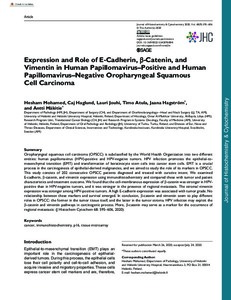Expression and Role of E-Cadherin, β-Catenin, and Vimentin in Human Papillomavirus–Positive and Human Papillomavirus–Negative Oropharyngeal Squamous Cell Carcinoma
Hesham Mohamed; Caj Haglund; Lauri Jouhi; Timo Atula; Jaana Hagström; Antti Mäkitie
Expression and Role of E-Cadherin, β-Catenin, and Vimentin in Human Papillomavirus–Positive and Human Papillomavirus–Negative Oropharyngeal Squamous Cell Carcinoma
Hesham Mohamed
Caj Haglund
Lauri Jouhi
Timo Atula
Jaana Hagström
Antti Mäkitie
SAGE PUBLICATIONS LTD
Julkaisun pysyvä osoite on:
https://urn.fi/URN:NBN:fi-fe2021042824972
https://urn.fi/URN:NBN:fi-fe2021042824972
Tiivistelmä
Oropharyngeal squamous cell carcinoma (OPSCC) is subclassified by the World Health Organization into two different entities: human papillomavirus (HPV)-positive and HPV-negative tumors. HPV infection promotes the epithelial-to-mesenchymal transition (EMT) and transformation of keratinocyte stem cells into cancer stem cells. EMT is a crucial process in the carcinogenesis of epithelial-derived malignancies, and we aimed to study the role of its markers in OPSCC. This study consists of 202 consecutive OPSCC patients diagnosed and treated with curative intent. We examined E-cadherin, beta-catenin, and vimentin expression using immunohistochemistry and compared these with tumor and patient characteristics and treatment outcome. We found that the cell-membranous expression of beta-catenin was stronger in HPV-positive than in HPV-negative tumors, and it was stronger in the presence of regional metastasis. The stromal vimentin expression was stronger among HPV-positive tumors. A high E-cadherin expression was associated with tumor grade. No relationship between these markers and survival emerged. In conclusion, beta-catenin and vimentin seem to play different roles in OPSCC: the former in the tumor tissue itself, and the latter in the tumor stroma. HPV infection may exploit the beta-catenin and vimentin pathways in carcinogenic process. More, beta-catenin may serve as a marker for the occurrence of regional metastasis:
Kokoelmat
- Rinnakkaistallenteet [27094]
